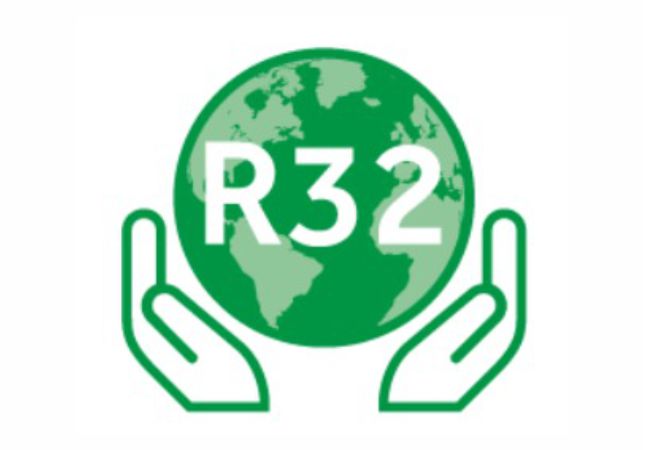Daikin is the only air conditioning equipment manufacturer that also produces refrigerants.
As recently as 2012, Daikin launched an air conditioner that uses the HFC-32 refrigerant, or simply R-32. The “Urusara 7” was the world’s first split-type air conditioner developed with R-32 refrigerant.
But what exactly is R-32?
It is a new class of refrigerant that has attracted great interest in the global industry due to its remarkable low environmental impact. R-32 is a pure HFC refrigerant, used in small air conditioners, and also as a component in HFC blends.
Compared to current refrigerants like R-22 and R-410A, it has a low global warming potential (GWP) and no ozone depletion potential (ODP). R-32 is mildly flammable.
We can note from the table below that R-32 offers only one-third of the GWP of R-410A, and nearly the same proportion compared to R-22.
It is known that the thermodynamic and physical properties of a refrigerant directly influence the system and the compressor.
Just to mention 2 of these properties:
– The saturation pressure of R-32 is similar to that of R-410A, which facilitates the development of a system based on R-410A.
– R-32 has a much lower density than R-410A, so the amount of refrigerant in the system (split) is smaller, and since GWP is measured in kilograms, the climate impact of R-32 in the system is even lower than suggested by its GWP.
Why did Daikin choose R-32?
Daikin was the first company in the world to successfully use R-32 in air conditioners, leveraging its experience as the only manufacturer that also develops and produces refrigerant fluids.
Before selecting R-32 for its air conditioners, Daikin analyzed several refrigerants and considered four criteria:
Environmental impact: As mentioned above, R-32 has zero ODP and one-third of the GWP of refrigerants R22 and R410A.
2. Energy efficiency: The efficiency of R-32 can be up to 1.5 times higher than that of R-410A or R-22. This potential is measured by a factor called "Cooling Seasonal Performance Factor" (CSPF). The peak energy consumption of R-32 is also lower.
3. Safety and Flammability: According to ISO 817/2014, R-32 is classified as having low flammability and low toxicity.
4.Cost-effectiveness: To select economical and efficient refrigerants, certain questions need to be asked, and R-32 performed well in the test.
– Is the refrigerant relatively inexpensive and easy to maintain?
– Does it contribute to reducing the overall operation and maintenance costs of the system?
– Is recycling feasible and relatively inexpensive?
As you can see, R-32 was a well-chosen refrigerant by Daikin.
And that's not all — besides manufacturing and selling R-32, Daikin provides technical assistance to governments and international organizations with the aim of training teams for the proper handling of R-32, among other ongoing activities.
Well everyone, the topic is extensive and interesting. I think this gives a good idea of what’s coming with R-32. We will return to discuss it in other articles.
